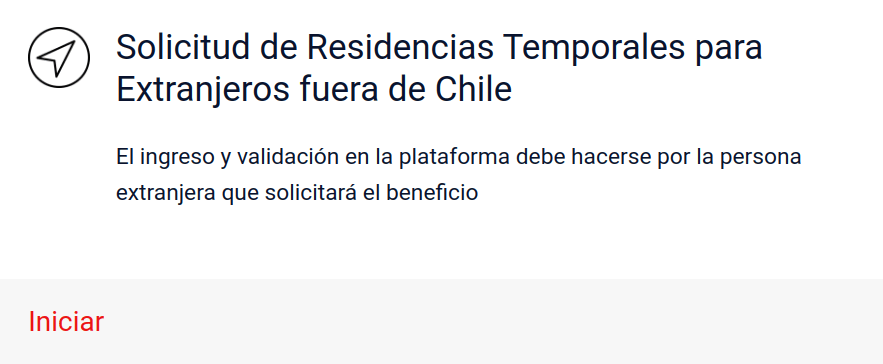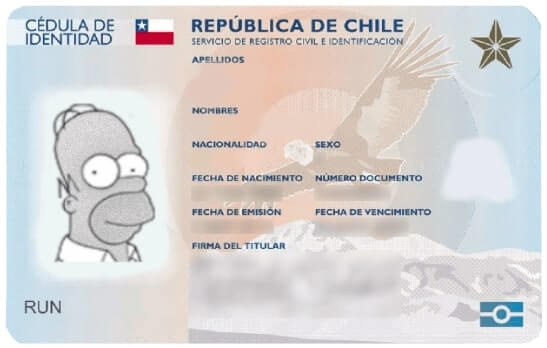Steps to follow to obtain a temporary residence permit and ID card (RUN/RUT) in Chile
Are you thinking of residing in Chile? In the following article we explain the steps you must follow to obtain a temporary residence permit and an identity card (RUN/RUT) in the country.
Table of Contents
1) Gather the documents required by the immigration authority
Currently, in Chile there are 16 subcategories of temporary residence or visas to which one can apply, and the requirements for applying to each one of them are regulated in the Supreme Decree 177 of 2022, which establishes the migratory subcategories of temporary residence. Thus, the documentation to be gathered will depend on the subcategory of temporary residence to which you will apply.
The subcategories of temporary residence are:
a) Family reunification permit (permiso de reunificación familiar).
b) Permit for foreigners who engage in licit remunerated activities (Permiso para extranjeros que desarrollan actividades lícitas remuneradas).
c) Permit for foreigners who seek to establish themselves in the country with the aim of studying in educational establishments recognized by the State (Permiso para extranjeros que busquen establecerse en el país con el objetivo de estudiaren establecimientos educacionales reconocidos por el Estado).
d) Permit for seasonal workers (Permiso para trabajadores de temporada).
e) Employment opportunities permit (Permiso de oportunidades laborales).
f) Permit for foreigners subject to the custody of the Gendarmería de Chile (Permiso para extranjeros sujetos a la custodia de Gendarmería de Chile).
g) Permit for foreigners who are in Chile by order of national courts of justice (Permiso para extranjeros que se encuentren en Chile por orden de Tribunales de Justicia nacionales).
h) Permit granted for humanitarian reasons (permiso otorgado por razones humanitarias). This permit is subclassified into: 1) Permit for victims of human trafficking; 2) Permit for victims of domestic violence or gender violence; 3) Permit for victims of illegal trafficking of migrants; 4) Special permit for pregnant foreign women; 5) Situation of children and adolescents.
i) Permit for people covered by international agreements (Permiso para personas acogidas a acuerdos internacionales).
j) Permit for religious leaders of officially recognized cults (Permiso para religiosos de cultos reconocidos oficialmente).
k) Permit for foreigners undergoing medical treatment (Permiso para extranjeros que se encuentren bajo tratamientos médicos).
l) Permit for retired foreigners and retirees (Permiso para extranjeros jubilados y para rentistas).
m) Permit for former holders of permanent residence (Permiso para ex titulares de residencia definitiva).
n) Permit for investors and related personnel (Permiso para inversionistas y personal relacionado).
o) Multiple entry business permit (Permiso de negocios de múltiple entrada).
p) Permit for refugees and political asylum seekers (Permiso para refugiados y asilados políticos).
You can find the documentation required for each one by going directly to Supreme Decree 177, or by checking the official website of the National Migration Service (Servicio Nacional de Migraciones), in the Temporary Residence section (Residencia Temporal).
Without prejudice to the specific documents required in each migratory subcategory, and unless expressly stated otherwise, the following documents must be attached to all applications (article 11 of the Supreme Decree 177/2022):
a) A copy of the applicant’s passport, which must be valid for at least 1 year from the date of the application.
b) In the case of applicants over the age of 18: Criminal record certificate or equivalent document issued by the competent authority of their country of origin, and if the applicant has resided in a different country for 5 years or more, the applicant will also have to attach the criminal record certificate of that country of residence.
All documents submitted by applicants for temporary residence that are in a language other than Spanish or English must be accompanied with the corresponding translation, which must be authorized by the competent authority (article 6 of the Supreme Decree 177/2022).
Documents submitted by applicants for temporary residence that were issued by a foreign public institution must comply with the legalization or apostille rules contained in articles 345 and 345 bis of the Code of Civil Procedure (article 7 of the Supreme Decree 177/2022).
Finally, temporary residence applications must be justified and accompanied by current documentation. In the case of documents issued by public bodies, they may not be earlier than 60 consecutive days from the date of issue. This period will be of 30 consecutive days in the case of documents issued by private entities. In qualified cases, upon request by the interested party, the National Director of the National Migration Service may accept documentation that does not comply with the stated period (article 8 of the Supreme Decree 177/2022).
2) Apply for temporary residence permit
With the required documents for the temporary residence subcategory to which you wish to apply, you must enter the National Migration Service’s website, log in with your account, select the process called “Solicitud de residencias temporales para extranjeros fuera de Chile” (Temporary residence applications for foreigners outside of Chile), fill out the application form, attach the respective documents in PDF format and pay the fees.

Once the application has been submitted, the applicant will receive a receipt for the temporary residence application that only indicates the start of the process, and will not allow the interested party to enter the country as a temporary resident (art. 77 of DS 177/2022).

It is important to remember that at the time of application, the applicant must be physically outside of Chile (article 58 of Law 21.325).
Exception (article 69 of Law 21.325): Those who apply for a temporary residence permit for family reunification or a temporary residence permit for humanitarian reasons may apply while physically inside of Chile. For all other temporary residence subcategories, the applicant must be physically outside of Chile.
3) Rectify the application if necessary
If the requirements for the requested temporary residence permit are not met, the National Migration Service will notify the applicant via email of a resolution titled “Solicitud incompleta o insuficiente – Otorga plazo para remitir antecedentes” (Incomplete or insufficient application. Grants time to submit documents).

It will indicate the documents that must be sent to the authority within a maximum period of 60 days and the reasons why they are required again (for example: lack of legalization or apostille, expired document, etc.).
The legal basis can be found in article 31 of Law 19.880, which establishes that if an application does not meet the legal requirements, the interested party will be required to correct the deficiency or attach the relevant documents within 5 days, indicating that if they do not do so, they will be deemed to have withdrawn their request. Although article 31 of Law 19.880 provides 5 days to rectify an application, the National Migration Service provides up to 60 days to do so (it is indicated at the end of the resolution):

4) Download your residence permit (Estampado Electrónico)
When the requirements are met for the temporary residence subcategory to which the application was made, the National Migration Service (Servicio Nacional de Migraciones) will grant the requested permit and make available the electronic document that certifies it (Estampado Electrónico or Electronic Stamp).
To download the Electronic Stamp, the applicant must enter the National Migration Service’s website, log in with their account, go to their Inbox and click on “Realizar” in the process titled “Descarga de Estampado Electrónico – Residencia Temporal”:
In cases where the applicant cannot download the Electronic Stamp digitally for any reason, they can go to the Consulate corresponding to the place from which they made their application to receive assistance in obtaining the electronic document in which their permit is recorded (article 52 DS 296/2021).
If 120 working days have passed since the date on which the foreigner is notified by email that their permit is available for download and they do not perform such action, said permit will lose its effectiveness, and in case they are interested in having a temporary residence permit, they must make a new application according to the general rules (article 52 DS 296/2021).
5) Enter Chile within 90 days
According to articles 72 of Law 21.325 and 52 of the Supreme Decree 296/2021, temporary residence holders granted to people outside of Chile will have a period of up to 90 consecutive days to enter the country in that category, counted from the date on which they downloaded their Electronic Stamps (Estampados Electrónicos) from the National Migration Service’s website.
The validity of permits granted outside of Chile will be calculated from the date of entry into the country, and such date must be incorporated by the border control authority (Policía de Investigaciones – PDI) in the National Register of Foreigners (articles 72 of Law 21.325 and 52 of the Supreme Decree 296/2021).
6) Requesting the identity card (RUN/RUT)
Finally, temporary residents must request an identity card from the Civil Registry and Identification Service (Servicio de Registro Civil e Identificación) within 30 days from the start of the validity of the residence permit (Article 43 of Law 21.325) – which, as we have seen, is the date of entry into the country.
Due to a lack of available hours to carry out the process of requesting an identity card from the Civil Registry and Identification Service, the National Migration Service issued Ordinary Office N° 40626 on July 15, 2022, informing about the calculation of the deadline established in Article 43 of Law N° 21.325.
According to the Ordinary Office published in July, the 30 days mentioned in Article 43 of Law 21.325 will be counted from the entry into force of the residence permit until the foreigner books an appointment on the website of the Civil Registry and Identification Service, thus initiating the process of obtaining the identity card.
The identity card will be issued in accordance with the names and surnames and validity period registered in the respective residence permit (Article 43 of Law 21.325).


Recent Comments